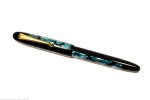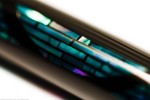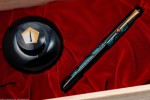The Namiki Yukari Nightline Moonlight is a cartridge-converter fountain pen manufactured by Pilot Pen Corporation in Japan. Accented by a two-tone gold nib and tapered ball-clip, it employs Togidashi maki-e and the “raden” inlay technique which entails the use of thinly sliced mother-of-pearl shells applied to urushi lacquer and burnished to create an iridescent finish which sparkles purple, emerald and turquoise.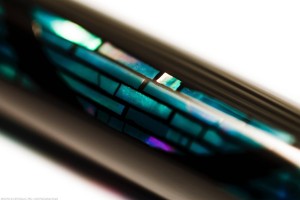
Prior to the Nightline Moonlight, Namiki made the Emperor Nightline and Yukari Nightline. As its name suggests, the Emperor is significantly larger. The Yukari Nightline features the sprinkling of gold dust in the negative space, as well as mother-of-pearl which is more purplish as compared to the current model. On a whole, the previous model was more ostentatious and feminine compared to the existing one.
Other pens in the Yukari series which sport the raden inlay technique are the Yukari Swallows with Cherry Blossom (Michifumi Kawaguchi), Yukari Firefly Raden (Kazuo Nihei, Mamoru Wakabayashi), the Yukari Yozakura Raden (Yumi Hayashi), as well as the Yukari Hydrangea Raden (Masato Sato). The Yukari Pine Needles and Yukari Herb Decoration also sport raden inlays, however the exact artist is not stated on the website. It is not certain if the pens are signed, and by which artist/s in the Namiki Kokkokai.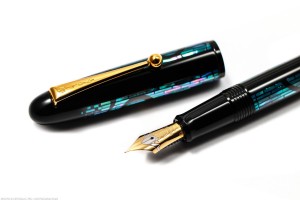
The technique we now know as “raden” was imported into Nara period (710-794) Japan from China in the Tang dynasty (618 – 907). Furniture covered with raden was popular in Europe in the 15th to 16th century, and was also popular in East Asia amongst the Straits Chinese or “Peranakan” who had their chairs and other furniture decorated with such inlays.
The arrival of the Portuguese in Asia in the 15th century saw an increase in production of lacquered products made for export to Europe – Frederic and Roth (2005) write that objects such as boxes, altar pieces, cabinets and lecterns were inlaid with mother-of-pearl and depicting Jesuit and Christian religious symbols.
On no other pen apart from the Nightline Moonlight is the application of raden as extensive – this makes Yukari Nightline Moonlight a rather ostentatious pen. Rectangular strips of sparkling mother-of-pearl are painstakingly applied to the black roiro-urushi surface one by one and parallel to each other. 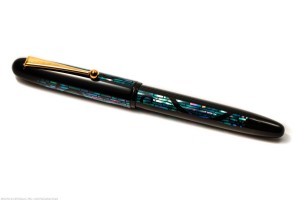
What makes the Nightline Moonlight unique is the fact that raden is not merely sprinkled on the pen, but applied very deliberately in rectangular blocks. This demands extreme accuracy and concentration, as each rectangular block is made up of many smaller rectangular blocks and there is negative space, which creates the appearance of black waves.
The Yukari Nightline Moonlight is a regular production model from the brand bearing the signature of artist Nobuko Sakamoto. The artist signs off in red as “Shinsai”. The pen is also signed “Kokkokai”, which refers to the group of artisans that work for Namiki. Nobuko Sakamoto and Yumi Hayashi (Namiki’s only female artisan) are the only artists who make this pen.
The Nightline Moonlight comes in a classy Paulownia wood presentation box lined with red velvet and containing a black ink bottle, instruction and guarantee booklet. It also contains a small card bearing the signature of the artist who created the pen. Unlike the same pen purchased in Europe and reviewed on Gourmet Pens, the local version does not come with a squarish box, but a rectangular box. It also does not include a guarantee card, nor does it contain a DVD with videos on Maki-e techniques.
The fountain pen is fitted with a 18k two-tone gold nib which bears the Namiki logo as well as an engraving of Mount Fuji. The nib’s right shoulder is engraved with the code “a-MYY” which refers to a welding machine in the Hiratsuka factory as well as the month and year of manufacture. As expected, the round nib performs perfectly out of the box and is aligned correctly. Pilot nibs are known to be smooth writers, and the medium is a safe choice as it is typically wetter. It would be favourable for Namiki to offer a wider variety of nibs for their Maki-e pens.
Fitted with a CON-70 converter that is lacquered black to match the appearance of the pen, the Namiki Yukari Nightline Moonlight Raden will be a delight to write with. The impressive capacity of the CON-70 gives it an advantage over Platinum and Nakaya pens, some of which cost in excess of US$4000.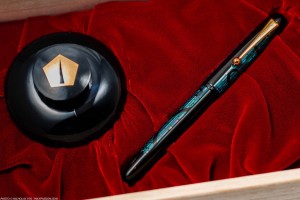
The Namiki Yukari Nightline Moonlight Raden is an attractive looking writing instrument from the Japanese brand. Although it is signed by the artist, it certainly isn’t a collectible piece or Limited Edition. That being said, it is probably one of the most classy raden fountain pens in the market – something which comes with a price to match.
The Namiki Yukari Nightline Moonlight was one of my grail pens. I started collecting fountain pens in 2008 and sometime that year I spotted it in shop display and was captivated. I wished that someday I would eventually own one, and I am glad that the day came sooner than later. I haven’t inked up the pen yet – I’ve left it in the box waiting for a special day. I already use the Fine nibbed Yukari Chinkin Matsu as a daily writer and it has served me well. It also doesn’t draw as much attention to itself as a pen completely covered with raden.
PROS
– Subtle yet classy application
– Has good weight in the hand
– Utilises CON-70 converter
– Nib performs out of the box
CONS
– Rather expensive daily writer
– Uninteresting nib selection
Photos:
References:
Frederic, L., & Roth, K. (2005). Japan Encyclopedia. Belknap Press of Harvard University Press. (ISBN: 978-0674017535)
For more information about Maki-e techniques, please refer to the following books:
Gerosa, A. (2012). Maki-e: A Story Waiting to be Written – A Journey through the World of Lacquered Fountain Pens. Milan: OPS S.r.l. (ISBN:978-88-901012-9-8)
Lyn, B. (2003). Maki-e, an art for the soul. (ISBN: 957-9403-07-4)




